The Top 8 Cube Gold Cards

With lists such as these I struggle with the cards I leave off far more than the order in which I place those that make it. There are some really big names that simply are not as good as those on the list. It is perhaps more interesting why these great cards don’t make a top 8 list in cube. The most notable absences will be Vindicate and Pernicious Deed, arguably the best spot and mass removal spells respectively. Vindicate was fairly easy to leave off. There are many comparable cards that do most of what it does, and in some ways more, such as Council’s Judgment, Hero’s Downfall and most recently Anguished Unmaking. The only thing Vindicate has on any of those is being a Stone Rain. Useful and occasionally game winning but pretty narrow and not something you feel like champion for doing! The rest of the time Vindicate is slow and expensive one for one removal that rarely puts you ahead or gains you value.
Pernicious Deed is still the best at doing what it does, but it doesn’t seem to get nearly as much opportunity to do that these days. Most of the power creep has been in creatures and so the decks that used to play Pernicious Deed without a second thought now have a lot of really strong things of their own the Deed will kill. Further to this, with planeswalkers not being affected by Deed you need to compensate for that as well. You used to be able to go find a Deed, lay it and threaten to kill every single threat they had in one go as and when it suited. These days I frequently find I have to do terrible things like use a Deed for zero to kill off just the tokens from a Goblin Rabblemaster else I will just be dead to the damage coming my way. Pernicious Deed is certainly more powerful than some of the cards on the list but then so is Nicol Bolas. Cube cards need to be powerful as well as highly playable and Deed has slipped on the latter measure.

This is a fairly calm looking card but do not be fooled. Some of the very best tempo openers involve this rogue. Bloodbraid Elf is a more powerful card than Shardless Agent, and it also sees more play with Gruul being a far better colour pairing than Simic. Despite this, the Shardless Agent is a much more consistent and reliable card than the mighty Bloodbraid. As a three drop with generic stats rather than a four drop with aggressive stats you can play Shardless Agent in any kind of deck and have it be very strong. With Bloodbraid you have to be fairly aggressive to get the most out of the card.
Cascading for lower values gives better return for your mana investment. If you assume a completely even spread on mana curve then your expected value from a Bloodbraid cascade is two mana while it is one and a half mana from the Shardless Agent. Lower cascades get a better return relative to the cascade value. They are also more reliable in the kinds of things you get. I have had many decks where I am guaranteed to get a ramp effect or an Ancestral Recall (Ancestral Vision) from a Shardless Agent.
You always get a two for one and you generally get a good tempo boost as well. Cards that are both tempo and value are generally the best kinds of cube card, especially when they are cheap. Shardless Agent also has many other subtle perks. Being an artifact and a creature helps with lots of various synergies. Even just knowing what you put to the bottom of your deck with the cascade can be valuable information. A great all round card that I play in a much higher proportion of Simic decks than I play Bloodbraid Elf in Gruul ones!

This has been described as the new Cryptic Command and I don’t think that is a bad description of the card. It is always a two for one and it can provide a tempo swing. It has a huge array of utility while also never being a dead card. While not quite as rounded or as potent as Cryptic Command, Kolghan’s Command is a whole mana cheaper to use making it that much harder to spot and much quicker to affect the game.
One of the hardest things to do in cube is have a deck with rounded solutions to problems. You don’t want to lose to a nasty piece of equipment but you equally don’t want to dilute your deck with a narrow Shatter effect. Kolghan’s Command does this perfectly, it lets you keep your card power level high while giving you good outs without the usual cost of having situational cards in your deck. I have been really surprised at how many Izzet and Dimir decks have ended up splashing the thirds colour just to play the Command.
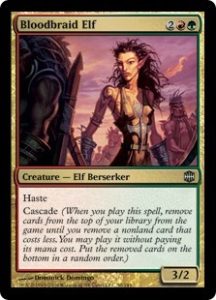
With two cascade cards on the list we can fairly well conclude that cascade is a very powerful mechanic. There is lots of counter synergy with cascade. It is poor with counter magic and generally any reactive cards. It is poor with creature buffs and terrible with X spells. Bloodbraid is just so powerful that you are more than happy to forgo all of these things when you have a Bloodbraid you want to play.
A 3/2 with haste is meaningful threat that while easy enough to answer will need that answer fairly sharpish. At four mana it is not a good deal at all in the cube when you can have something like a Falkenrath Aristocrat instead. Often enough you will hit a one mana Elf with your Bloodbraid and that always feels a bit weak but that is a bit of a deception. I would certainly rather have a Falkenrath Aritocrat in play than a Bloodbraid Elf and a Llanowar Elf as an aggressive player. That however is not a fair representation of the comparison. If having the Falkenrath means your next non-land draw is the 1/1 Elf then I would much rather the Bloodbraid side of the deal. When Bloodbraid hits a weak card you have improved your draws and gained a reasonable board presence for the mana. At the other end of things when Bloodbraid hits a good target with the cascade you are so far ahead it is unfair. Domri Rade and Boggart Ram-Gang seem to be the most common things that Bloodbraid cascades into and you feel unfairly crushed!
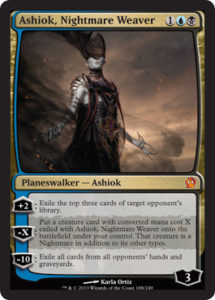
At number five this card might seem high but I would place it even higher up in a top planeswalkers list. A lot of the reason Ashiok, Nightmare Weaver is so potent in cube is the difference between forty and sixty card decks. With cube being so powerful and fast, full of cantrip, draw and tutor effects that thin libraries the value of mill in cube is about twice that of mill in constructed formats. Imagine if it was +2 loyalty to mill for five instead of three. That is not far off how much better the card is in cube. The +2 is not just a means to find things for the -X ability but a very threatening effect in its own right.
Aggressive decks generally have to attack Ashiok as it will reliably get value with the -X if left unchecked. This is really hard to do in one hit and usually means Ashiok absorbs close to ten damage and often causes some chump attacks as well. None of the other three mana planeswalkers are as tough to take out as an aggressive player nor as important to do so. Control and combo decks have it far worse. With it being exile rather than just to the graveyard the danger of having key cards removed is too much for them. Either they directly answer it or it has increasingly good odds of ending the game without doing anything more than +2 it. Ashiok is a great threat early or late, it is hard to remove, easy to protect and gives some interesting options once the -X ability is online.
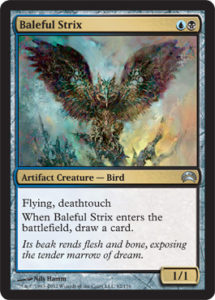
The card which has no drawbacks. I play this in every deck that contains Dimir colours if I can. The Strix costs no cards and little mana yet it trades with most attackers and really needs to be removed if you don’t want to take a bad trade. When you have no attacks it will peck away at your life and your planeswalkers and be fairly annoying in that way too. It is better than Wall of Omens at being a good defensive play yet it is still good enough to play in aggressive Delver and affinity decks! The cube is a format where almost any minor one or two mana effect can be made playable by the addition of drawing a card the Strix is easily the most impact on the board of any such card.
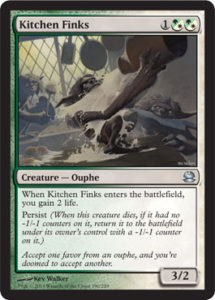
As we reach the very best of the gold cards in magic we start to find that they are not really gold cards in the conventional sense. Most gold cards are restrictive in where you are able to play them as you are required to be in a specific combination of colours making them narrow. Kitchen Finks can be played in blue white control as easily as black green mid range yet it is technically a Selesnya gold card. There are certainly more powerful cards on this list and even some that are not however none of them are close to being as playable as Kitchen Finks.
On top of being more playable than most mono coloured cards the Kitchen Finks also has the double whammy of being value and tempo simultaneously. This makes it a good card for aggressive decks and for control decks alike. Kitchen Finks is the best anti red aggro card in the cube. It is close to a four for one against a red deck a lot of the time. It is generally a good blocker able to trade up quite easily and still leave you with a board presence. As the aggressor the finks is a good card against all kinds of removal allowing you to extend more and lay out relatively safe threats. It will also really help to swing any game in which you find yourself racing.
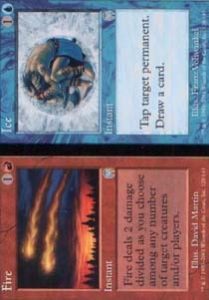
One of my favourite cards of all time. I not only play this in almost every Izzet deck I construct but frequently play it in blue or red decks with little or no access to the other colour. Both halves are good enough to be played alone yet do very different things. Combining them gives the best all round utility tool in the game. It is better than any Charm or Command card and far far more playable. Unlike a lot of utility cards which are fine at worst in any given matchup, Fire / Ice is always good to game winning in any matchup. Tap that Mana Vault or the thing you just brought in with the Sneak Attack. Kill your Birds of Paradise and your Lotus Cobra. Oh, your on two, kill you.
Fire / Ice interacts with all the fundamental mechanics of the game, it taps things, damages things and draws card. By interacting on these base levels Fire / Ice is able to interact with more other cards than almost any other. While it is not that often a removal spell it can have the same effect as one with clever use. A well timed tapping of a land can be a Time Walk.
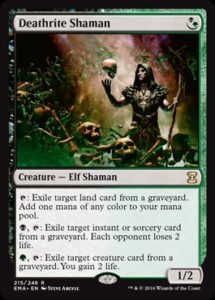
Simply put Deathrite Shaman is too good. It is not only stupidly far above the curve in terms of value for mana but it breaks the colour pie and gives black a Birds of Paradise. With only one total coloured mana required to cast it Deathrite is more playable as a splash or off colour than either Fire / Ice or Kitchen Finks on top of being significantly more powerful.
When you have access to both black and green mana Deathrite Shaman is a Swiss army knife of utility and options. The card would still be fantastically good if it only had the first ability that makes mana. As it stands it fights a lot of different things in a number of different ways. Deathrite can represent two unblockable damage a turn and is a very good way to close out a game. On the flip side of things he can provide two life a turn and stall the game long enough that you can get back into it. The threat of the life gain makes it kill on sight for aggressive red decks. Graveyard disruption is a big deal as well with lots of archetypes utilising recursion, flashback and other such effects. Deathrite can negate the vast majority of these strategies. I feel the need to remind people at this stage that all of this is on top of it being a 1/2 Birds of Paradise that is easier to cast and usable by black! Deathrite does a surprising amount of work just blocking things too…
While I have directly compared it to Birds of Paradise a lot it is not accurate to assume you can always use the effect. Sac lands are used extensively in cube and lead to reasonable odds of a turn two mana activation from the Shaman. There is also a fair amount of discard floating around which slightly improves those odds. Having a Deathrite in play early is a little more like having a Lotus Petal or Pentad Prism than it is a Birds of Paradise. You won’t be able to tap it for mana every turn but you will have that burst of mana when you need it. You will also have plenty else to do with your one drop when not using it as a mana source.
Disagree with my choices for this top eight or just curious as to why other cards were not even mentioned? Feel free to let me know in the comments section below and I’ll do my best to answer your queries.




